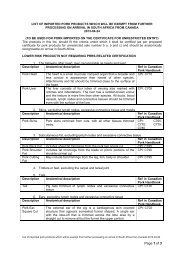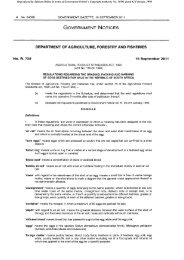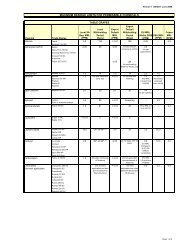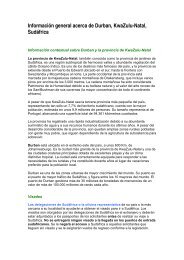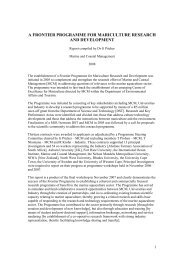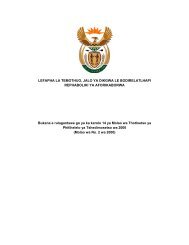Create successful ePaper yourself
Turn your PDF publications into a flip-book with our unique Google optimized e-Paper software.
Rock crabs generally have almost square bodies, limbs with<br />
curved pointed claws and well-developed nippers. They hide<br />
in rocky crevices and feed mainly at night on seaweed, shell-<br />
fish and small animals. There are only two common species<br />
on the west coast but many on the east coast.<br />
Swimming crabs have flat bodies and pad-<br />
dle-shaped back legs, used for swim-<br />
ming or to flick sand over their backs<br />
when they settle into the sand. They are<br />
aggressive, fast-moving predators. The largest<br />
species, the giant mud crab, can reach up to 30 cm and has<br />
powerful nippers and is commercially fished from estuaries. It is<br />
vulnerable to over-exploitation, because of its slow growth rate.<br />
Ghost crabs live on the east coast. At dusk they emerge<br />
f rom burrows in the sand, to scurry across the beach in<br />
search of turtle hatchlings, plough shells and other animals<br />
stranded by the waves. They have box-shaped bodies,<br />
one enlarged nipper and prominent, stalked eyes.<br />
Fiddler crabs occur commonly in lagoons,<br />
estuaries and mangrove swamps. The male has<br />
a distinctive large coloured nipper which he<br />
waves to attract the female. They work the<br />
sand into little balls as they remove<br />
organic matter for food.<br />
Sponge crabs use their nippers to cut off<br />
pieces of sponge, which are held over the back with the two<br />
small back legs. The sponge grows to cover the crab pro v i d i n g<br />
it with camouflage and protection. When the crab moults it<br />
looses its sponge coat and has to start with a new one.<br />
Xanthid crabs have stout, heavily-built bodies and one<br />
massive nipper used to crush shells. They are important and<br />
diverse predators on the east coast.<br />
An alien crab: the European shore crab, Carcinus maenas,<br />
was first introduced to South Africa in 1983, possibly on oil-<br />
rigs. By 1990 it had spread 120 km to Saldanha Bay. It is a<br />
voracious pre d a t o r, which decimated the shellfish industry when<br />
it was introduced to America, and poses a threat to local marine<br />
life but is confined to sheltered water in harbours and bays.<br />
Mole crab<br />
Anomura – hermit crabs etc.<br />
Crabs with unsegmented abdomens and reduced back legs.<br />
P o rcelain crabs a re fragile and shed their legs, especially the<br />
nippers, when threatened by an enemy. The cast-off nipper<br />
sand and filter<br />
will continue to snap while the crab<br />
makes its escape.<br />
Mole crabs, or sea lice, are<br />
barrel- shaped crabs that roll up<br />
and down the shore in the breakers. They dig into the<br />
particles of food from the water using their long hairy<br />
antennae. They are caught for use as bait.<br />
Giant deep-sea crabs dance over the seabed as if on long<br />
stilts. Although they can grow up to 2 m across, their nippers<br />
a re proportionally quite small. They are harvested commerc i a l l y<br />
Hermit crab<br />
by the Japanese.<br />
Hermit crabs are well known for their habit of living<br />
in empty sea-snail shells. Their<br />
abdomen is soft and curved to fit into the<br />
shell and ends in a stiff tail fan, which the<br />
crab employs to wedge it in the shell. The<br />
f ront nippers are used for defence, to collect<br />
food and seal the entrance to the shell. There<br />
are only two pairs of walking legs as the two back<br />
pairs of legs are reduced and help to grip inside the shell. Most<br />
hermit crabs are scavengers and occur in sandy lagoons and<br />
pools. They have to move into bigger shells as they grow.<br />
Author: Margo Branch September 2000<br />
Classification:<br />
PHYLUM Arthropoda<br />
SUBPHYLUM Crustacea<br />
CLASS Malacostraca<br />
FURTHER INFORMATION:<br />
• Branch, G. M. & Branch M. L. 1981. The Living Shores of Southern Africa . Struik, Cape Town.<br />
• Branch, G. M., Griffiths, C. L., Branch M. L & Beckley, L. E. 1994. Two Oceans: A guide to the marine life of southern Africa, David Philip, Claremont, Cape Town.<br />
RELATED FACTSHEETS:<br />
• Crustaceans • Rock lobsters • Rock Pools • Mangrove Swamps<br />
ORDER Decapoda – Lobsters and crabs<br />
SECTION Brachyura – True crabs<br />
Anomura – Hermit crabs etc.<br />
For more information, please contact: The Coastal Management Office, Marine and Coastal Management, Department of Environmental Affairs and Tourism, Private Bag X2,<br />
Roggebaai 8012, Cape Town, South Africa. Tel: +27 (0)21 402-3208 Fax: +27 (0)21 418-2582 e-mail: czm@mcm.wcape.gov.za Website: http://sacoast.wcape.gov. z a





